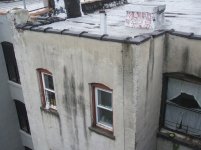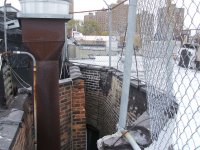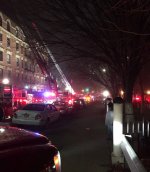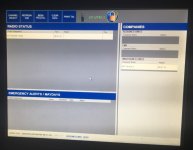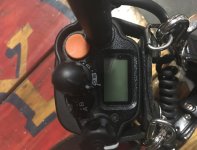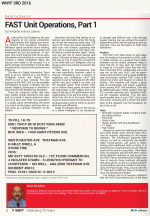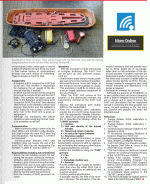
Do We Really Do RIT Justice?
5.23.2013By Stuart Grant and Bret Stidham
I know as you read the title of this article you thought, “Yeah, yeah, here is another guy harping on rapid intervention.” But look inside your organization and ask yourself: does your agency really do rapid intervention justice? Many fire departments across the nation say they provide rapid intervention, but is it just lip service or do you really dedicate a company to providing this service? Many times if we meet two-in/two-out, we say we have rapid intervention taken care of. Other times, departments look around and, if they see two people outside of the fire, they consider rapid intervention taken care of; they just assume that if something goes wrong or someone issues a Mayday, they can grab those people. This cannot further from the truth. They are relying on luck, and luck can get people injured or killed!
A BRIEF HISTORY OF RIT
Rapid intervention or firefighter rescue is not something new. We can trace some of the earliest attempts at organizing firefighter rescue back to 1915 in New York City. On March 8, 1915, FDNY’s Rescue 1 went into service as a resource for assisting trapped firefighters. Rescue 1 was equipped with the specialized equipment of the day. Things rocked along until the late 1960s and early 1970s when the London Fire Brigade designated “Emergency Teams” equipped with emergency air supply equipment and air transfer lines. These were the early attempts at what we now know as rapid intervention team (RIT) packs. In 1980, the Occupational Health and Safety Administration enacted 29CFR 1910, which provided for the “buddy system” in IDLH atmospheres. Later, in the same standard, 29CFR1910.134.G.4 became known as the two-in/two-out rule. This required that four people had to assemble prior to entry–two would remain outside to provide immediate assistance to the two inside, if needed. In 1986, the National Fire Protection Association (NFPA) published NFPA Standard 1500, Standard on Fire Department Occupational Safety and Health Program, which is a consensus standard to provide a health and safety standard for fire departments andstates that “there should be personnel prepared to initiate rescue operations.” In 2001, the NFPA published NFPA Standard 1710, Standard for the Organization and Deployment of Fire Suppression Operations, Emergency Medical Operations, and Special Operations to the Public by Volunteer Fire Department, which recommended that the initial arriving company should have the capability to implement the initial RIT (IRIT) and that the IRIT should be replaced by a full RIT. That same year, the 77th Legislature for the State of Texas passed Senate Bill 382, which made two-in/two-out the law in the state of Texas.
While all of these standards and recommendations were being written, tragedies were happening across the country. On July 25, 1987, John Nance was killed in the line of duty when he became trapped in a basement in Columbus, Ohio. Acting Lieutenant Nance had fallen through a collapse in the floor; several rescue operations were undertaken but he succumbed to his injuries before he could be removed. On September 28, 1992, Denver (CO) Firefighter Mark Langvardt was killed during a commercial building fire. He was trapped in a small storage room on the second floor and was unable to self-extricate from the building. Over the course of an hour, there were more than a dozen unsuccessful attempts to remove Firefighter Langvardt from the building. These two incidents were paramount in increasing the attitude of firefighter safety and lead to several programs to educate the fire service on saving ourselves. It also stimulated the fire service to thinking about rescuing our own. But then on March 14, 2001, the Phoenix (AZ) Fire Department lost Firefighter Bret Tarver during a fire in a supermarket. After many rescue attempts, Firefighter Tarver was removed from the building but succumbed to his injuries. Phoenix did an outstanding job researching RIT and RIT operations and became a leader in firefighter safety. But did the rest of us listen?
Those were fires in large commercial buildings that required the response of multiple alarms and firefighters. What about RIT in smaller departments and at smaller incidents? Two tragic loss-of-life fires that happened prior to 2001 were in Lake Worth and in Houston, Texas. Both of these incidents occurred in smaller commercial buildings and happened during the initial attack phase of the operation. In both incidents, a dedicated RIT was not in place. We must constantly ask ourselves, how do we protect our firefighters during single-alarm responses or multiple-alarm responses? Don’t we owe it to them and their families?
According to multiple articles in national fire service publications and multiple after action reports (AAR), the resounding truth about RIT is that if teams are not in place or cannot perform in a safe and timely manner, firefighters may die or be seriously injured. Not only could the original firefighter be killed or injured, but poorly trained and/or equipped personnel sent in to rescue them may perish as well.
THE DALLAS SOLUTION
Dallas (TX) Fire-Rescue’s (DFR) engine companies and truck companies ride with four members. This allows for the two-in/two-out requirement to be met with the initial company arriving on scene. Also dispatched on the first-alarm assignment is a second truck company that responds as a dedicated RIT company. For many years, this was the plan and our answer to fulfilling the RIT commitment to our members. Many times the companies that were assigned RIT duties have viewed this as though they were being slighted by not being assigned a firefighting activity; alternately, some saw this as a front-row seat to simply watch the action.
Although all firefighters have basic training in RIT operations, Dallas Fire-Rescue decided to elevate our commitment to firefighter safety. A proposal was made to involve DFR’s Special Operations Division in the RIT role. This would be accomplished by offering advanced-level training to its Special Operations Urban Search and Rescue (USAR) team members as a dedicated RIT. An assessment was conducted to validate the desire to offer specialized training to members of the special operations group in anticipation of future operations involving downed or injured firefighters. Deputy Chief Stuart Grant and Captain Bret Stidham from the department’s special operations teams observed internal responses, studied multiple AARs, and spoke to other agencies that had lost members in the line of duty to determine what the best course of action for DFR would be. Since DFR already has a highly trained Type 3 USAR team on staff and ready to respond at all times, it was determined that the best route would be to better make use of their training and expertise. This would also give the department another return on its investment in the USAR program. The next step would be to conduct RIT training with this particular group and provide them with the knowledge, skills, and abilities to perform this role. Dispatch protocols were developed that the department would continue with the second truck as RIT on the first alarm and they would be replaced with a 10-person RIT from the USAR team on the second alarm.
Since the RIT may have to perform very technical rescues, these unique challenges could not be remedied by a simple classroom course. The training needed to be technical in nature and involve a lot of hands-on opportunities and practical exercises to evaluate the participants’ knowledge, skills, and abilities. Not only was this a recommendation of Grant and Stidham, but it was also a strong recommendation from participants in a pilot course held in Colorado during 2011.
The results of the pilot course were used to strengthen the training program and ensure the needs of the participants and the department were met. Areas of improvement that were identified during the pilot course included the need to include additional practical exercises, hands-on opportunities, and more “tricks of the trade” to help the participants understand what works and what does not work in real-world situations. The participants enjoyed the classroom portion of the training but they wanted the opportunity to apply what they learned in the classroom with simulated scenarios involving RIT activation.
To satisfy their request, help was solicited from Lanita Magee, the emergency management coordinator for the Dallas Department of Aviation, to help create a 24-hour training program. The program was designed to include the classroom portion and four practical exercises of increasing complexity. These exercises have allowed the participants to exercise and evaluate their own performance while providing them with an opportunity to enhance their knowledge, skills, and abilities.
The classroom portion introduces the students to the concept of rapid intervention, the history of rapid intervention, tools and equipment, self-preservation (including self-rescue, drags, communications), and how to set a RIT team up for maximum effectiveness. The first of the exercises concentrates on self awareness, evaluation and skills to help remove themselves and a firefighter from a Mayday situation. The scenario is arraigned so that a firefighter issues a Mayday and the RIT has to locate the firefighter, assess them, place on RIT air and remove them from the location. The second scenario builds upon the first by increasing the distance the firefighter is in the building, therefore requiring the RIT to “hand off” the down firefighter several times. The third scenario incorporates several obstacles to reach the firefighter and also includes entanglement devices that the RIT must overcome to remove the down firefighter. The team must perform a forcible exit to remove the firefighter and themselves from the structure. The fourth exercise continues to build complexity and the RIT must extricate the down firefighter out of the structure the same way they entered the structure. This scenario incorporates an elevation change inside the structure. Recently, a fifth scenario was developed that can be used in place of one of the original scenarios or added to the program if time permits. This scenario replicates an actual incident in Dallas that claimed the life of one of our firefighters.
Lieutenant Todd Krodle lost his life on August 14, 2011, when he fell through the roof of an apartment complex and became trapped in the trusses of the attic. This provided several challenges to locate, reach, and extricate him. Incorporating these different scenarios lets us design the hands on portion to fit the needs of the department and to fit different time constraints that may be placed on them. With this training program in place, the special operations division was able to meet the requirements of NFPA Standard 1407, Standard for Training Fire Service Rapid Intervention Crews.
The best thing that we can do in memory of our fallen brothers and sisters is teach others from their incidents. Rapid intervention is an important aspect of the firefighting profession. If we are going to send the most valuable resource our departments have (our people) into a burning structure, don’t we owe it to them and their families to have the resources to go and get them if something goes wrong? If we cannot provide proper rapid intervention with enough people to actually perform rapid intervention, then maybe we don’t go in!
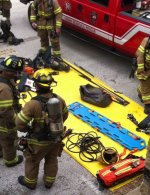
(1) All RIT equipment is laid out on the RIT tarp. Equipment is selected depending on the type of structure involved. Check sheets have been incorporated to ensure nothing is overlooked.
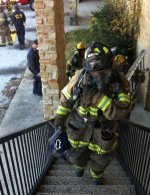
(2) The first RIT team responds to the Mayday from their staging area. The initial deployment is two members tosearch, find, and locate. Two additional members are ready to bring needed equipment or manpower. Three additional two person teams are ready also for a total of a ten person RIT team.
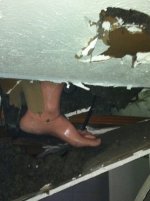
(3) The Mayday firefighter is trapped in an attic space. This is all that can be seen of him, his foot through the sheetrock.

(4) Members work to locate the firefighter in the attic.
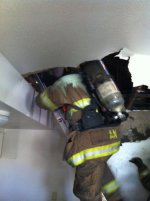
(5) Once the firefighter is located, then a large area in the ceiling is opened to be able to access the firefighter and remove them.
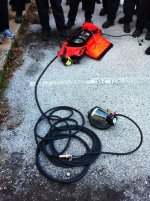
(6) The RIT pack with a fifty foot section of air hose proved to be a valuable asset to assisting the member in the attic. The RIT pack is left on the floor and the face piece attached to the air line is taken to them in the attic.
STUART GRANT, CFO, MIFireE, a 34-year veteran of the fire service, is a deputy chief with Dallas (TX) Fire Rescue in the special operations division. Stuart is certified as a master firefighter and fire instructor with the Texas Commission on Fire Protection. Stuart has served in many capacities within the Department including academy commander, hazmat officer, paramedic, and rope rescue member. He is a task force Leader for the Dallas regional USAR team and the state’s second USAR team (TX-TF2). He also has been a HOT instructor and speaker at FDIC and FDIC West, and instructs at Collin College in McKinney, Texas, and at the Texas A&M University Municipal Fire School. He has two associates’ degrees and a bachelor’s degree in fire administration. He has also been recognized by the Center of Public Service Excellence as a “Chief Fire Officer” and by the Institution of Fire Engineers as a “Member.”
BRET STIDHAM is a 19-year veteran of the Dallas (TX) Fire-Rescue Department. He is a captain assigned to Truck 19 in east Dallas. Bret is certified as a master firefighter and Level III fire instructor with the Texas Commission on Fire Protection. Bret has served in several capacities within the department including a hazmat officer, an USAR officer and instructor at the department’s training academy. He is a rescue manager with Dallas’ USAR team (TX-TF2) and a rescue specialist with TX-TF1. Bret has taught at Collin College in McKinney, Texas, Tarrant County Community College in Ft. Worth, Texas, and at various locations around the country. He also has an associate’s degree in fire administration.

Do We Really Do RIT Justice?
The best thing that we can do in memory of our fallen brothers and sisters is teach others from their incidents. Stuart Grant and Bret Stidham discuss an intensive training program for rapid intervention developed by Dallas (TX) Fire-Rescue.
Last edited:


